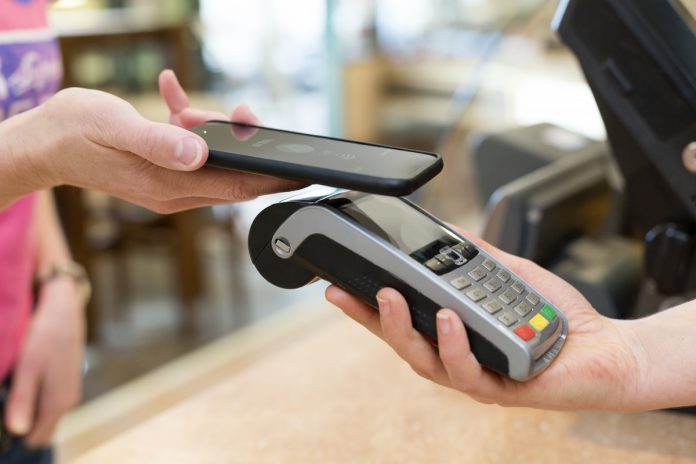The telephone has come a long way in its evolution from a simple communication device to a multi-functioning minicomputer that we use every day to interact with the world around us.
When mobile companies like Samsung and Apple integrated payment capabilities in their smart devices, it allowed customers to shop at their convenience, quite literally from the palms of their hands. The advent of wearable devices, such as smartwatches and other technology in the mobile age has also made it easier for users to make payments on the move.
Payment Expert spoke to Jeremy Nicholds, CEO of Judopay, about consumer attitudes towards mobile payments and how businesses should respond.
Payment Expert: What is the current attitude from UK shoppers towards mobile retail payment methods?
Jeremy Nicholds: From our research, it’s clear that UK customers’ frame of mind around mobile payments, especially amongst millennials, is optimistic. Our findings show that UK shoppers have a positive outlook about mobile payments when it comes to three aspects: speed, convenience and flexibility.
30% of UK consumers choose to pay by mobile because it’s quicker. Over a quarter (27%) of UK consumers choose to pay by mobile because they think it’s the most convenient channel. Further to that, in terms of flexibility, nearly 1 in 3 UK millennial consumers (30%) choose to purchase via mobile because it allows them to ‘pay on the go’.
With the current health crisis, we naturally expect a strong uptake in cashless commerce as both consumers and businesses move away from ‘dirty money’. This is a result of more people trying to shop online and the recent BBC announcement that supermarkets are now trying to dissuade people from using cash in-store, favouring card payments instead.
PE: What impact can it have on consumer engagement if the payment procedures are slow?
JN: Customer satisfaction and service is one of the most important factors for any business. At Judopay, we pride ourselves on being mobile first. When it comes to mobile payments, customers expect the checkout to be quick and easy to complete. A slow or poorly designed checkout can result in cart abandonment and potentially damage customer loyalty.
We found that when consumers make a purchase, they expect the payment to be seamless and instantaneous. When the payment process becomes too slow, our research indicates that 1 in 6 UK consumers will cancel their purchase. Overall, the average drop-off rate at mobile checkout is still 69%. Also, almost a third of UK consumers have expressed that nothing frustrates them more than when a merchant’s mobile payment process doesn’t work or is too slow.
It’s clear that consumers want mobile checkouts to be fast, especially in a world where technology has set high expectations by speeding up processes, giving consumers instant consumption and gratification via their smart devices. This is what businesses need to keep in mind when it comes to customer service.
PE: Can you tell us some of the issues that would leave retail customers feeling frustrated with mobile payments?
JN: The mobile retail space is highly competitive, and customer experience is vital as it gives m-commerce businesses an edge over its competitors. So, if the mobile payments checkout process doesn’t meet consumer expectations, it will leave them frustrated, which subsequently, will lead to abandoned baskets. Ultimately, businesses will miss out on potential sales.
So, what are some of the issues that leave customers frustrated with mobile payments? Amongst mobile users, we found a lack of trust to be the biggest issue.
An overwhelming 61% of respondents think that shopping through mobile increases the likelihood of big tech companies (e.g. Facebook and Google) having access to their data. With only 5% of people choosing to pay by mobile because they feel it’s more secure than PC.
So, the dilemma for businesses is how to offer a great user experience, whilst at the same time ensuring customers feel safe, without creating more friction by adding extra layers of security.
This comes down to striking a balance between UX and security – and to master this art, businesses need to partner with all the right stakeholders, across security, payments, design and marketing.
PE: How difficult is it to appeal to multiple generations through mobile payments?
JN: Millennials are more connected to technology than any other previous generation and are a driving force behind exciting emerging technologies. 49% of GenZ and 47% of millennials are comfortable with the companies that they buy from having their data to help improve their next shopping experience.
Going back to trust, the challenge businesses are having is that they’re trying to replicate the millennial mindset around security, across all generations.
Alongside this, the customer journey from sign-up to checkout must be as simple, quick and clear as possible for every generation to make their purchases. This is another reason why UX is pivotal when shopping online.
Businesses need to provide ways in which the older generation can understand the benefits of embracing digital payments. At Judopay, we find education is a key driver to helping all generations benefit from mobile payments.
PE: What innovations do you feel are next when it comes to increasing efficiency and engagement within mobile payments?
JN: We’ve seen a lot of new and emerging innovations in payments in recent years with the likes of biometrics, blockchain and mobile wallets being used across various regions – and are continuing to become more prevalent across the UK.
One method of payment that we foresee being used more and more by UK businesses, residents and international tourists, is QR codes. QR codes are convenient access points that work the same way as barcodes. A popular payment method in Asia and Africa, QR code apps like Alipay and India’s Paytm have taken the market by storm and continue to gain momentum in those regions.
In the UK, there have been clear indications that businesses are now accepting QR codes as a method of payment to appeal to international tourists, especially in the hustle and bustle of London and Manchester’s Chinatown.
The prevalence of QR codes used in other parts of the world isn’t fully replicated within the UK market. At this moment in time, UK residents and businesses are still getting comfortable with using contactless and cashless payments.
For QR codes to replace contactless and cashless payments, businesses and consumers must see a greater value in it. For now, QR codes are commonly used for brand interaction, but we’ll no doubt see it being used as a payment method in the near future.
PE: How impactful do you believe 5g will be on mobile payments?
JN: 5G services have been around for a few years now, but it was only until recently that the technology capable of utilising it was available to consumers. This new technology will be 3 times faster than 4G and will decrease latencies, leading to more customisable and seamless payment processes for consumers.
As a result, we’ll no doubt see more and more consumers adopt mobile payments due to the higher convenience, speed and flexibility factors that 5G will bring.






















